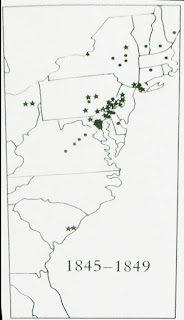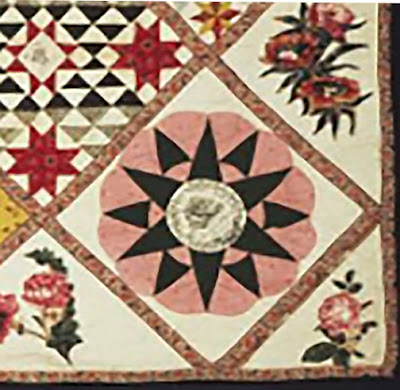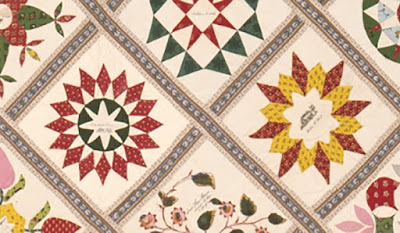Blocks from a quilt associated with Sarah Morrell
some dated 1842-1843.
Museum of American Folk Art
Album quilt associated with Quaker Ella Maria Deacon (1811-1894)
Burlington County, New Jersey, Blocks dated 1841-1842
Art Institute of Chicago
Read the inscriptions here:
American patchwork didn't have a good deal of pattern variety until 1840. The fashion for creating album or friendship quilts with each block an individual design seems to have began about 1842, based on the dated examples.
Album quilt associated with Charlotte Ware Gillingham Hancock
Blocks dated 1842-1843
Philadelphia Museum of Art
Years ago I made a map of dated quilts with place names both single pattern (dots) and album samplers (stars) in the years 1840-1844. This sampler maps shows two clusters in the Delaware Valley and Baltimore. (Now I'm a little skeptical on the dates of those pre-1844 Baltimore samplers.)
The whole idea of album sampler quilts with their amazing variety of pieced, appliqued and cut-out chintz blocks seems to have developed in the Trenton/Philadelphia area in the early 1840s.
In the later 1840s the fashion spread
Ten years after the fad began
the women in the Delaware Valley
seem to have been over it.
Pennock Family album, 1842-1843
Chester County Historical Society
Sarah Wistar Pennock's star based on ten points
in the Pennock quilt, pieced over paper templates
Thanks to Sandra Starley for taking and posting such
great detail photos when she visited the Chester County Museum.
My guess is ladies' academies. The Delaware Valley was THE place to send your girl to school whether she walked a few Philadelphia blocks to classes or was packed off from Virginia to board in Burlington, New Jersey.
The Pennock "family members had the opportunity to study under English sewing teachers and respected mathematics and calligraphy instructors in the Society of Friends' Pennsylvania schools."
Isabella L. Pennock
Mississippian Varina Howell (1826-1906)
boarded at a French school in Philadelphia
in the early 1840s. She went home to marry
Jefferson Davis in 1845.
School girls and their teachers?
I wonder if these album blocks and the quilt style they created were a product of clever teachers who combined sewing, drawing, and mathematics lessons with the young woman's desire for a strong friendship circle, leaving a durable legacy.
I did not originate this idea. In 1986 Tandy Hersh gave a paper at an AQSG seminar on the Pennock quilt and I have not forgotten it. She concluded that girls schooled at Quaker academies "would have developed the skills necessary to design and sew intricate blocks in a quilt and do the ink art work and penmanship found on the quilt." She also noted that the skill levels in inking and stitching on the Pennock quilt varied.
Collection of Colonial Williamsburg
Generations of Pennock women in an 1870 portrait
The Pennock "family members had the opportunity to study under English sewing teachers and respected mathematics and calligraphy instructors in the Society of Friends' Pennsylvania schools."
Philadelphia Museum of Art
Block from quilt dated 1842-1843, attributed to Philadelphia Quaker
Charlotte Ware Gillingham Hancock (1822-1883)
Art Institute of Chicago
Blocks from the Ella Maria Deacon quilt.
Burlington County, New Jersey, Blocks dated 1841-1842
Two blocks based on six divisions in a quilt (1842) in Sandra Starley's collection.
1842
Did 72-year-old Sarah Wistar Pennock create the complex
patchwork pattern, stitch it or ink the block with its Whig
imagery of a log cabin and a cider barrel. A granddaughter or two may
have collaborated on the block with her name on it.
The history of women's education before the Civil War is overlooked but it seems that these early sampler album quilts tell us a good deal about what was happening in classrooms the early 1840s in Pennsylvania and New Jersey. And it's certainly no wonder that the fashion for album quilts spread so far so fast.
New York's Rutgers Female Institute, 1848
Read Tandy Hersh's paper on the Pennock quilt here:
And that's the end of this 3-post series.



















No comments:
Post a Comment